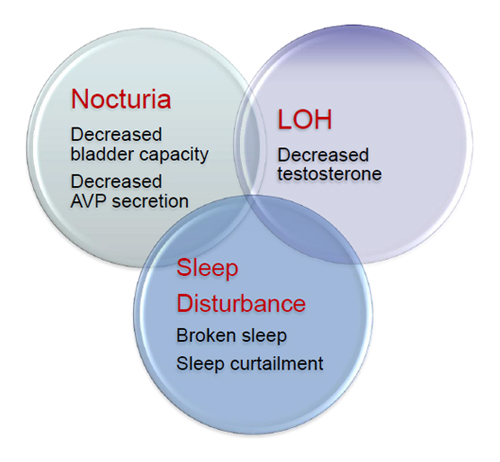|
< Waking to void at least once during sleep >
- Increases with Age
ㆍ1 in 2 adults over 50
원인
- Etiology: Prostate? OAB?
ㆍAlpha blockers reduce Nocturia by 0.2 episodes per night, 5ARIs less effective
ㆍAnticholinergics reduce Nocturia by 0.7 per night
ㆍMost resistant to treatment among BPH symptoms
ㆍPrevalent equally among Men and Women
● Sleep homeostasis for endocrine regulation

▶ Which occurs first?
- nocturia-induced stress decreases testosterone levels
- decreased testosterone by aging causes nocturia
● Mechanism : T & Sleep disturbance
▶ Disruption of Circadian hormones by Nocturia
- Psychological and physical stress such as deprivation of sleep significantly decrease testosterone levels
- Frequent awakening can also decrease the testosterone level.
● Aging Changes of Circadian Rhythms
▶ A central mechanistic issue in human male reproductive aging is whether low-amplitude and disorderly pulsatile LH secretion in older men is an intrinsic neuroregulatory anomaly or a secondary neuroendocrine response to partial androgen deficiency. >
▶ The process of aging commonly affects sleep architecture
- increasingly fragmented by arousals and awakening episodes
- poor sleep maintenance and consolidation
- shorter overall sleep time
▶ These effects are similar to those observed with lower T conc.
- decrease in sleep efficiency,
- lower number of REM sleep episodes
- altered REM sleep latency
● Testosterone changes after sleep deprivation (SD)/sleep restriction
▶ Sleep loss is considered to be a health risk factor
- several disease processes, reduces longevity, behavioral and hormonal alterations
▶ Increasingly common Chronic sleep loss in industrialized societies and it affects about 45% of adults.
▶ Normal average sleep duration : 8.0- 8.9 h/night in 1960; 6.9-7.0 h in 2000-2002
▶ SD induces changes in the endocrine axis.
- reduction in circulating androgens in healthy men
- decreased estrone levels and increased levels of progesterone, PRL,
corticosterone, and catecholamines after 4 days of SD in male rats
잠을 안재우면 남성호르몬 level이 10-15% 감소하고 정상적으로 나이에 따라
해마다 1~2%감소하며 stress H인 cortis이 증가해 gonadal 기능 감소시킨다.
● Effect of 1 Week of Sleep Restriction on Testosterone Levels in Young Healthy Men

▶ 10 young healthy men, 1 wk of SR to 5 hours per night, a condition experienced by at least 15% of the US working population
- Daytime T levels were decreased by 10% to 15%
- Normal aging ass. T decrease levels by 1-2% per year
- T decline was associated with lower vigor scores but not with increased levels of cortisol, a stress-responsive hormone that can inhibit gonadal function.
● Take Home Messages
▶ In aging male, increasing incidence of nocturia with lack of sleep are important issue in QOL for consequent decrease of testosterone.
▶ Still debating, nocturia showed a negative correlation with serum T levels and sleep loss by nocturia decrease T and treatment of nocturia can restore testosterone in selected populations of severe nocturia and lower serum T.
▶ But identification of definite cut-off value of T related to nocturia is not so simple for multifactorial pathophysiology, circadian rhythm, sleep and no established accurate T level assay.
▶ Further studies are requested to elucidate the causal relationship of nocturia and testosterone.
|